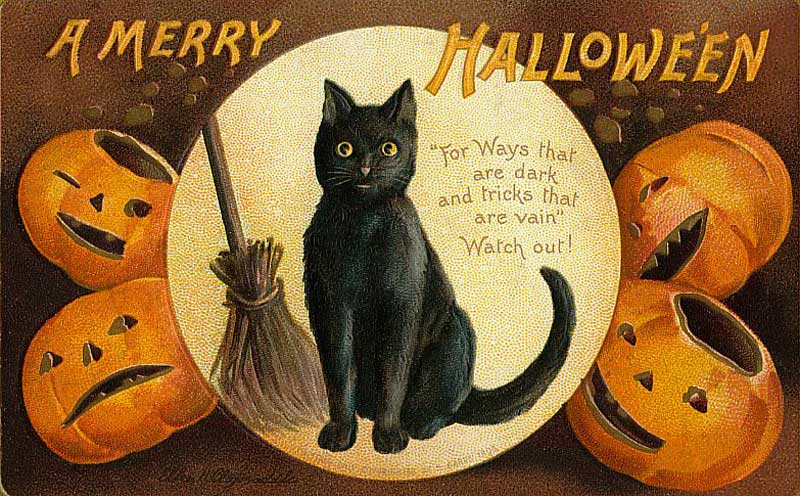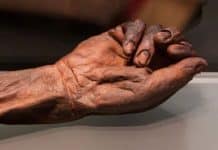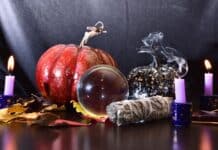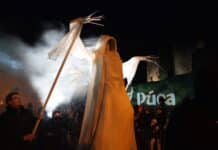JON KANEKO-JAMES takes a special look at the origins of Halloween – the night the dead come back to haunt the living

THERE is no single Halloween. The name itself, Halloween, comes from Hallowtide, also sometimes called Hallowmass, encompassing the festivals of All Souls’ on the 31st of October and All Saints on the 1st of November.
The ancient Celts celebrated it for three days before and after the part of the year that is now November 1st, and the Elizabethans observed Hallowtide from October 31st to just after November 5th, eventually all but combining the whole thing with their celebrations of bonfire night. But even that isn’t the whole story.
You might have heard Halloween called Samhain, or Sowan.
The quaint idea leaps to mind of a dark Pagan festival, brought from prehistory and forced to hide in Christian clothes… and the festival was dark: this was the dying of the summer, when the leaves started falling and food would become more scarce.
Most importantly, the night would come gathering in.
Darkness was a frightening thing before the era of streetlights: a moonless night was effectively blackness.
Even walking abroad could be fatal with travellers being killed as they fell down embankments and into ditches, without the predation of wolves and bandits. Strange shapes and noises would haunt the darkness.
As the world ground to a halt the ancient Celts needed something to get it started again, a ritual act that would kick the world’s momentum back into gear.
This was the night of the 31st.
In Ireland, folklore insisted that all fires would be extinguished for the night. Ulstermen and women would gather together, clustering around the leaders and kin.
In their crowded fortresses of light they would drink and dance in defiance of the darkness.
Nature’s slowing momentum meant that the world of man was weaker than ever.
A fragment written at the time says, “Any Ulsterman who did not come Samhain night to Emain (a fortress of the Irish Kings) would lose his reason and his… tomb would be and stone would be erected the next morning.”
As the world ground to a halt the ancient Celts needed something to get it started again, a ritual act that would kick the world’s momentum back into gear.
Spirits, faeries and the dead were abroad in the darkness. And the celebrations themselves were critical.
Maedb, the Irish goddess of drunkenness, was also associated with limnality. Her name itself meant middle, and the ancient Celts saw the state of drunkenness as an altered state with magical connotations. The feast would also involve the consumption of pork, a mystical meat said to have given the Tuatha De Dannan their magical powers and immortality.
In fact, for the night the world didn’t really belong to humans.
It belonged to the ‘other,’ until the morning where the King would re-light the fires… sometimes literally, with a symbolic lighting of fires, other times figuratively after a grim sacrifice. Some victims would be drowned, others beheaded. In fact, the motif of the mystical severed head runs through Celtic myth, appearing with the talking head of Bran the Blessed and Peredur ap Efrog in the Welsh Mabinogion. This ritual death would spark nature once more, and restart the wheel of nature.
Christian Halloween was a related festival, but not in the sense of being a descendant. In the 9th Century Irish clergy were the driving force of Christian Evangelism in Europe, having succeeded in bringing Christianity to Pagan heartlands… yet they needed something to finish Christianising their own homeland.
To this end the festival of All Souls, where Christians would pray for the souls in Purgatory, was moved to the day of October 31st, the day before All Saints on November 1st. The reason was ostensibly so that the power of the Saints would be able to intervene on behalf of the souls suspended between heaven and hell. Thus, Hallowtide was born: a festival with the same connections to the otherworld and the dead, but with the added bonus that the King doesn’t need to be sacrificed.
And the dead could be propitiated. Requiem masses soothed them; bells were rung for twenty-four hours to ward off ghosts and demons. In some towns, Charnel Houses – repositories containing the bones of the dead – would be opened and decorated with flowers. Cadavers would be dressed in robes. and venerated in niches along the walls. Food would be left out for the dead.
Song and light were a good way to drive off demons and appease any of the dead who had been tempted to return and claim recompense against the living: bonfires were set in cemeteries to ward off the dead. In St. Mary Woolnoth, London, five garlanded young women were hired to play harps by lamplight as late as 1539. This is the time where we start to get some of the features of Halloween that modern people would recognise. The strong association of the festival with visitations and the supernatural was joined by gift giving in the form of good Christian charity, after all the harvest was over and food was going to be scarce for the poorer members of the community.
Tables would be laden with soul cakes at the community celebration.
Everyone would get one, and later the poor of the parish would go ‘souling’ from door to door, begging for soul cakes at every house they encountered. Those who didn’t give might be set upon by drunken revellers, tricked or publicly humiliated with being forced to ride on the ‘cowlstaff,’ a wooden rod carried between two revellers.
Masking came into things, too, with local girls blacking up to hide their faces and young men donning strange, monstrous guises like the Hobby Horse, or donning old wedding dresses. Strange festivals would emphasise the eeriness of the season, like the candlelit processions along the hilltops or torch-lit processions across the Derbyshire moors, leading out of town and into the wilderness, out as far as the Purgatory Farms, where the Hallowtide rite of Teanlay would performed, praying out the fires.
By the 18th Century the Reformation had eroded the associations between Hallowtide and Purgatory, but the association with the supernatural had remained: except now it was a lighter festival, where couples would divine their fate and singletons would be able to see the face of their future lovers. Beggars went souling from door to door, but now they asked for money.
As a rhyme said: “My clothes are very ragged/ my shoes are wearing thin/ I’ve got a little pocket/ to put a halfpence in…”
Hallowtide parties began a run of festivals through the darkest part of the year from Hallowtide until Christmas that persist in one form and another, marked by masking and misrule, to this day.







